Key molecular requirements for raft formation in lipid/cholesterol membranes
- PMID: 24498317
- PMCID: PMC3911970
- DOI: 10.1371/journal.pone.0087369
Key molecular requirements for raft formation in lipid/cholesterol membranes
Abstract
The lipid mixture of DPPC (saturated lipid)/DUPC (unsaturated lipid)/CHOL (cholesterol) is studied with respect to its ability to form liquid-ordered and liquid-disordered phases. We employ coarse-grained simulations with MARTINI force field. All three components are systematically modified in order to explore the relevant molecular properties, leading to phase separation. Specifically, we show that the DPPC/DUPC/CHOL system unmixes due to enthalpic DPPC-DPPC and DPPC-CHOL interactions. The phase separation remains unchanged, except for the formation of a gel phase at long times after decreasing the conformational degrees of freedom of the unsaturated DUPC. In contrast, the phase separation can be suppressed by softening the DPPC chains. In an attempt to mimic the ordering and unmixing effect of CHOL the latter is replaced by a stiff and shortened DPPC-like lipid. One still observes phase separation, suggesting that it is mainly the rigid and planar structure of CHOL which is important for raft formation. Addition of an extra bead to the head of CHOL has no notable impact on the phase separation of the system, supporting the irrelevance of the Umbrella model for the phase separation. Reduction of the conformational entropy of CHOL by stiffening its last bead results in a significant increase of the order of the DPPC/CHOL domain. This suggests that the conformational entropy of CHOL is important to prohibit the gelation process. The interleaflet interactions as mediated by the terminal molecular groups seem to have a strong impact on the possibility of a subsequent gelation process after phase separation.
Conflict of interest statement
Figures

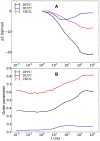


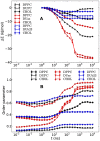
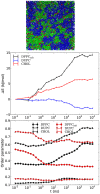
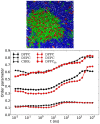

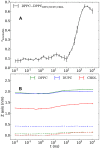

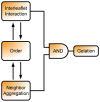
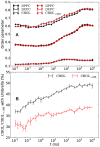
Similar articles
-
Predictions of phase separation in three-component lipid membranes by the MARTINI force field.J Phys Chem B. 2013 Apr 18;117(15):4072-80. doi: 10.1021/jp4000686. Epub 2013 Apr 9. J Phys Chem B. 2013. PMID: 23534606
-
Phase separation in a lipid/cholesterol system: comparison of coarse-grained and united-atom simulations.J Phys Chem B. 2013 Apr 11;117(14):3841-51. doi: 10.1021/jp312245y. Epub 2013 Mar 29. J Phys Chem B. 2013. PMID: 23470157
-
Probing lipid-cholesterol interactions in DOPC/eSM/Chol and DOPC/DPPC/Chol model lipid rafts with DSC and (13)C solid-state NMR.Biochim Biophys Acta. 2013 Aug;1828(8):1889-98. doi: 10.1016/j.bbamem.2013.03.028. Epub 2013 Apr 6. Biochim Biophys Acta. 2013. PMID: 23567917
-
Lipid lateral diffusion and membrane heterogeneity.Biochim Biophys Acta. 2009 Jan;1788(1):234-44. doi: 10.1016/j.bbamem.2008.08.016. Epub 2008 Sep 6. Biochim Biophys Acta. 2009. PMID: 18805393 Review.
-
Atomistic Monte Carlo simulation of lipid membranes.Int J Mol Sci. 2014 Jan 24;15(2):1767-803. doi: 10.3390/ijms15021767. Int J Mol Sci. 2014. PMID: 24469314 Free PMC article. Review.
Cited by
-
Composition Fluctuations in Lipid Bilayers.Biophys J. 2017 Dec 19;113(12):2750-2761. doi: 10.1016/j.bpj.2017.10.009. Biophys J. 2017. PMID: 29262367 Free PMC article.
-
Assembly of Cell-Free Synthesized Ion Channel Molecules in Artificial Lipid Bilayer Observed by Atomic Force Microscopy.Membranes (Basel). 2023 Oct 25;13(11):854. doi: 10.3390/membranes13110854. Membranes (Basel). 2023. PMID: 37999340 Free PMC article.
-
Biocompatible and optically stable hydrophobic fluorescent carbon dots for isolation and imaging of lipid rafts in model membrane.Anal Bioanal Chem. 2022 Aug;414(20):6055-6067. doi: 10.1007/s00216-022-04165-6. Epub 2022 Jun 14. Anal Bioanal Chem. 2022. PMID: 35697813
-
Inserting Small Molecules across Membrane Mixtures: Insight from the Potential of Mean Force.Biophys J. 2020 Mar 24;118(6):1321-1332. doi: 10.1016/j.bpj.2020.01.039. Epub 2020 Feb 4. Biophys J. 2020. PMID: 32075746 Free PMC article.
-
Understanding Conformational Dynamics of Complex Lipid Mixtures Relevant to Biology.J Membr Biol. 2018 Dec;251(5-6):609-631. doi: 10.1007/s00232-018-0050-y. Epub 2018 Oct 22. J Membr Biol. 2018. PMID: 30350011 Free PMC article. Review.
References
-
- Simons K, Ikonen E (1997) Functional rafts in cell membranes. Nature 387: 569–572. - PubMed
-
- Lingwood D, Simons K (2010) Lipid Rafts As a Membrane-Organizing Principle. Science 327: 46–50. - PubMed
-
- Simons K, Vaz WLC (2004) Model systems, lipid rafts, and cell membranes. Annu Rev Biophys Biomol Struct 33: 269–295. - PubMed
Publication types
MeSH terms
Substances
LinkOut - more resources
Full Text Sources
Other Literature Sources
Medical

